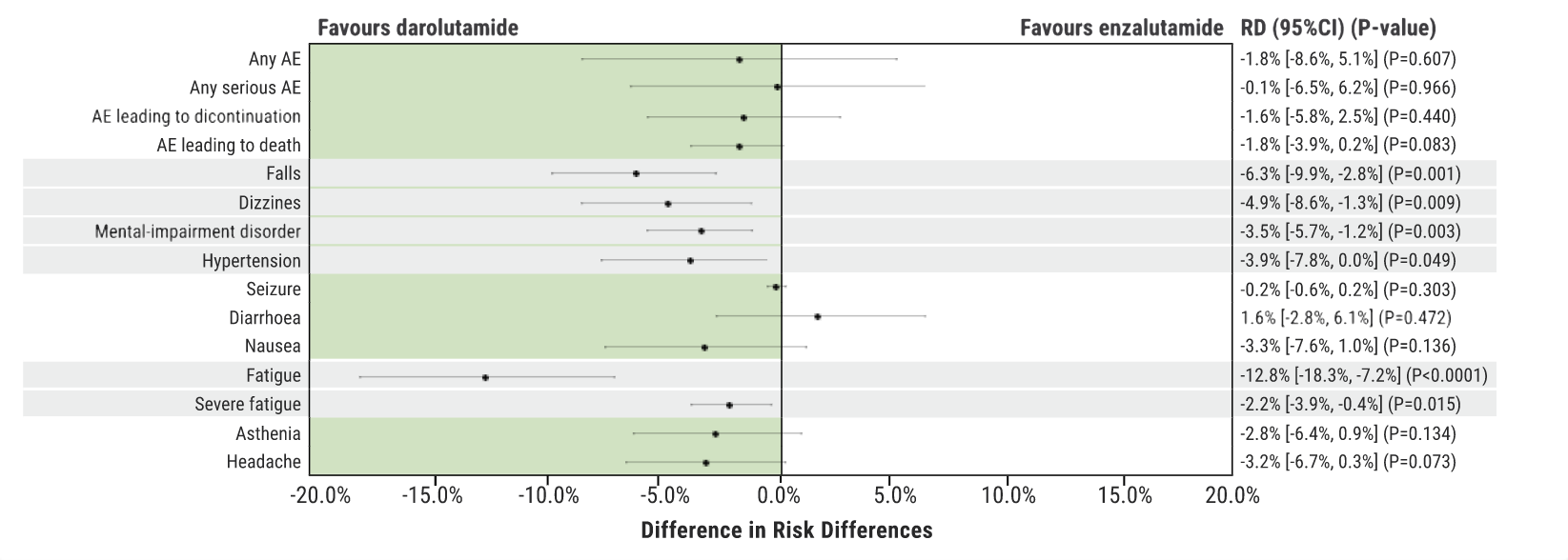ARAMIS was a randomised, double-blind, placebo-controlled, phase 3 trial in men with nmCRPC and a prostate-specific antigen doubling time of 10 months or less. Patients were randomly assigned to receive darolutamide (300 mg tablets twice daily) or placebo while continuing androgen-deprivation therapy. The primary endpoint of metastasis-free survival was already met [1]; however, there were questions as to whether the benefit of using androgen-inhibitors would translate to an OS benefit.
With a median follow-up of 29 months, Prof. Karim Fizazi (Institut Gustave Roussy, France) presented the final OS rates from ARAMIS, after 254 deaths had occurred (15.5% from the darolutamide arm, and 19.1% from the placebo arm), as being 83% and 77% on the darolutamide and placebo arms, respectively (n=1,509; HR 0.69; 95% CI 0.53-0.88; P=0.003) [2]. Importantly, darolutamide also met key secondary outcomes, including delaying time to pain progression, with a median 40.3 months versus 25.4 months with placebo (HR 0.65; 95% CI 0.53-0.79; P<0.001). Darolutamide also significantly delayed the time to first cytotoxic chemotherapy and time to first symptomatic skeletal event versus placebo. “These results provide compelling evidence for early darolutamide treatment in men with nonmetastatic CRPC,” concluded Prof. Fizazi.
In an interesting companion study, patient-level data from ARAMIS (darolutamide vs placebo, n=1,509) was compared with the SPARTAN (apalutamide vs placebo, n=1,207) and PROSPER (enzalutamide vs placebo, n=1,401) trials for safety outcomes. Dr Shan Jiang and colleagues applied a match-adjusted indirect comparison method to perform indirect treatment comparisons adjusting for cross-trial heterogeneity [3]. For the general safety outcomes, no statistically significant differences were observed between darolutamide and apalutamide or enzalutamide after matching. However, darolutamide showed a numeric advantage over both enzalutamide and apalutamide on adverse events leading to treatment discontinuation and adverse events leading to death, whereas apalutamide showed a numeric advantage over darolutamide on any serious adverse events. Among individual adverse events, darolutamide had a statistically significant lower risk of falls, fracture, and rash compared with apalutamide. Compared with enzalutamide, darolutamide had a lower risk of falls, dizziness, mental impairment, fatigue, and severe fatigue (see Figure).
In conclusion, this analysis suggests that, after adjusting for trial differences and multiple testing, darolutamide showed a generally favourable safety profile when compared to apalutamide and enzalutamide.
Figure. Differences in risk differences for darolutamide versus enzalutamide safety outcomes [3]

- Fizazi K, et al. N Engl J Med. 2019;380(13):1235-1246.
- Fizazi K, et al. ASCO Virtual Meeting, 29-31 May 2020, Abstract 5514.
- Jiang S, et al. ASCO Virtual Meeting, 29-31 May 2020, Abstract 5561.
Posted on
Previous Article
« Final survival results from phase 3 SPARTAN trial Next Article
Urothelial cancer: avelumab works as maintenance therapy »
« Final survival results from phase 3 SPARTAN trial Next Article
Urothelial cancer: avelumab works as maintenance therapy »
Table of Contents: ASCO 2020
Featured articles
COVID-19 & Telemedicine
COVID-19 and Cancer Consortium Registry: initial results
Oncology hospital-at-home model reduces hospitalizations, emergency department visits, and costs
Nurse-led telephone triage system reduces hospitalizations, helps patients manage symptoms at home
Melanoma
Adjuvant pembrolizumab: durable RFS for stage III melanoma
Adjuvant pembrolizumab: durable RFS for stage III melanoma
Pembrolizumab plus low-dose ipilimumab well tolerated after progression on PD1 antibody therapy
Toripalimab plus axitinib effective in metastatic mucosal melanoma
Breast & Ovarian Cancer
Advanced breast cancer: locoregional therapy does not improve OS
T-DM1 does not improve safety or efficacy in HER-2 positive early breast cancer; favorable iDFS reported
Maintenance olaparib improves OS in relapsed ovarian cancer with BRCA1/2 mutation
Combination pembrolizumab/chemo improves PFS in metastatic TNBC
Effect of veliparib with or without cisplatin in breast cancer: results of SWOG S1416
PHOEBE, a phase 3 trial comparing pyrotinib and lapatinib in HER2-positive metastatic breast cancer
BYLieve demonstrates efficacy of PIK3CA-directed treatment post CDK4/6-ihibition
Strategies emerge for chemotherapy de-escalation in HER2-positive breast cancer
Multiple Myeloma
Carfilzomib: no PFS benefit for multiple myeloma
Lung Cancer
ES-SCLC: tremelimumab + durvalumab + chemotherapy misses endpoint
Adjuvant osimertinib in NSCLC: practice changing ADAURA trial
ES-SCLC: pembrolizumab KEYNOTE-604 data
Second-line gemcitabine plus ramucirumab significantly improves overall survival
Tiragolumab and atezolizumab: ORR in NSCLC
MET-amplified advanced NSCLC responds well to MET inhibitor capmatinib
Genitourinary Cancer
Urothelial cancer: avelumab works as maintenance therapy
ARAMIS final OS and nmCRPC safety outcomes
Final survival results from phase 3 SPARTAN trial
Novel drug for kidney cancers/VHL patients
Primary analysis from IMvigor010, adjuvant atezolizumab in high risk muscle-invasive urothelial carcinoma
First randomised trial of Lu-PSMA in mCRPC progressing after docetaxel
Gastrointestinal Cancer
HER2-expressing metastatic colorectal cancer: trastuzumab deruxtecan
REGOMUNE: a phase 2 study combining regorafenib and avelumab
Cardiotoxicity: consider switching to S-1
Perioperative chemotherapy for resectable pancreatic ductal adenocarcinoma
Real-world data of sequential sorafenib followed by regorafenib in unresectable HCC
Paediatric Cancer
Sustained improvements in quality of life with larotrectinib
Promising first immunotherapy trial in placental trophoblastic tumours
Precision medicine for poor-prognosis paediatric patients
Related Articles

February 23, 2021
Adjuvant pembrolizumab: durable RFS for stage III melanoma
© 2024 Medicom Medical Publishers. All rights reserved. Terms and Conditions | Privacy Policy
HEAD OFFICE
Laarderhoogtweg 25
1101 EB Amsterdam
The Netherlands
T: +31 85 4012 560
E: publishers@medicom-publishers.com

